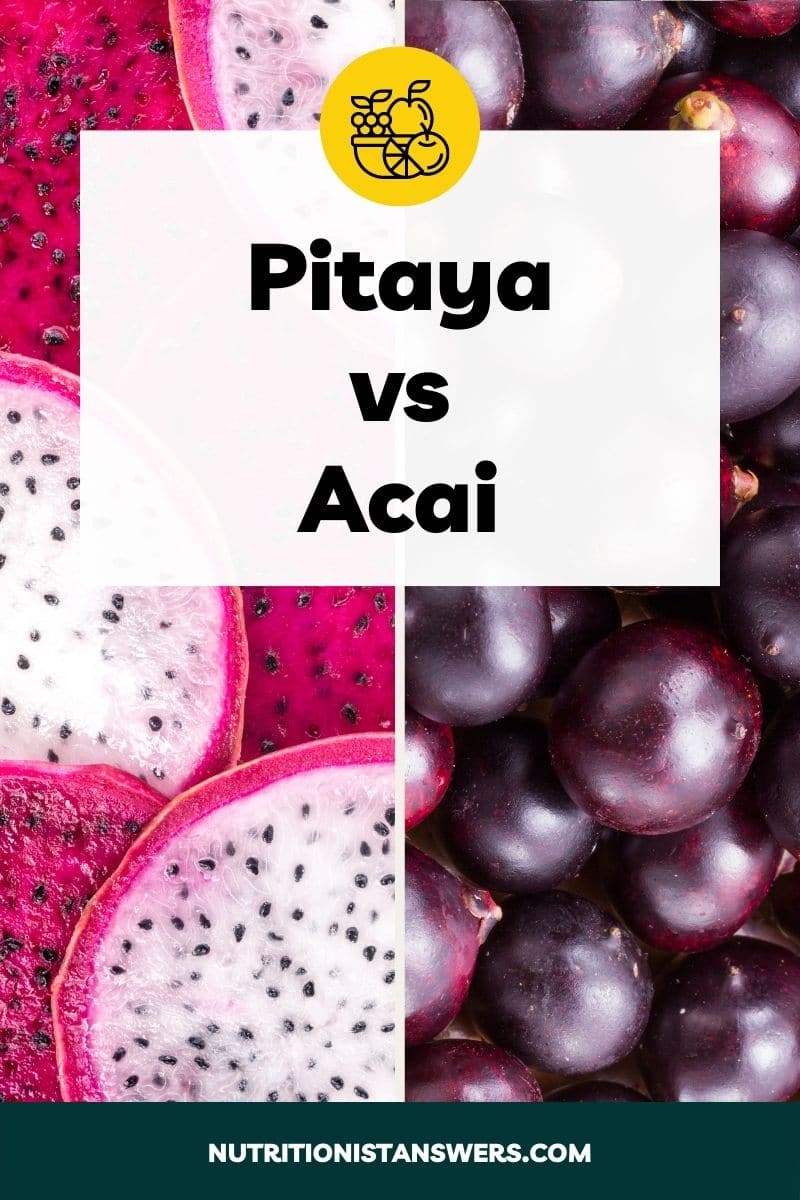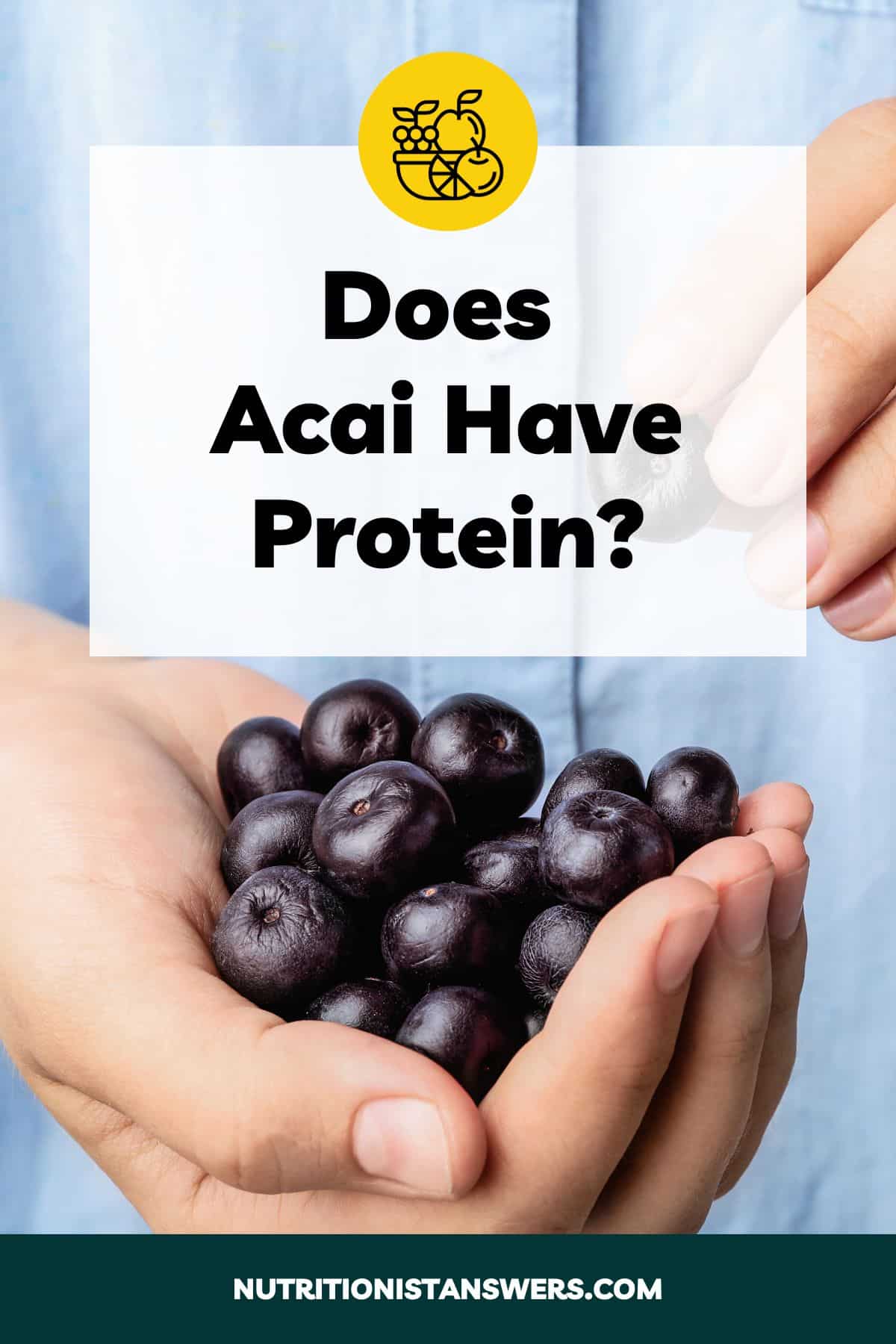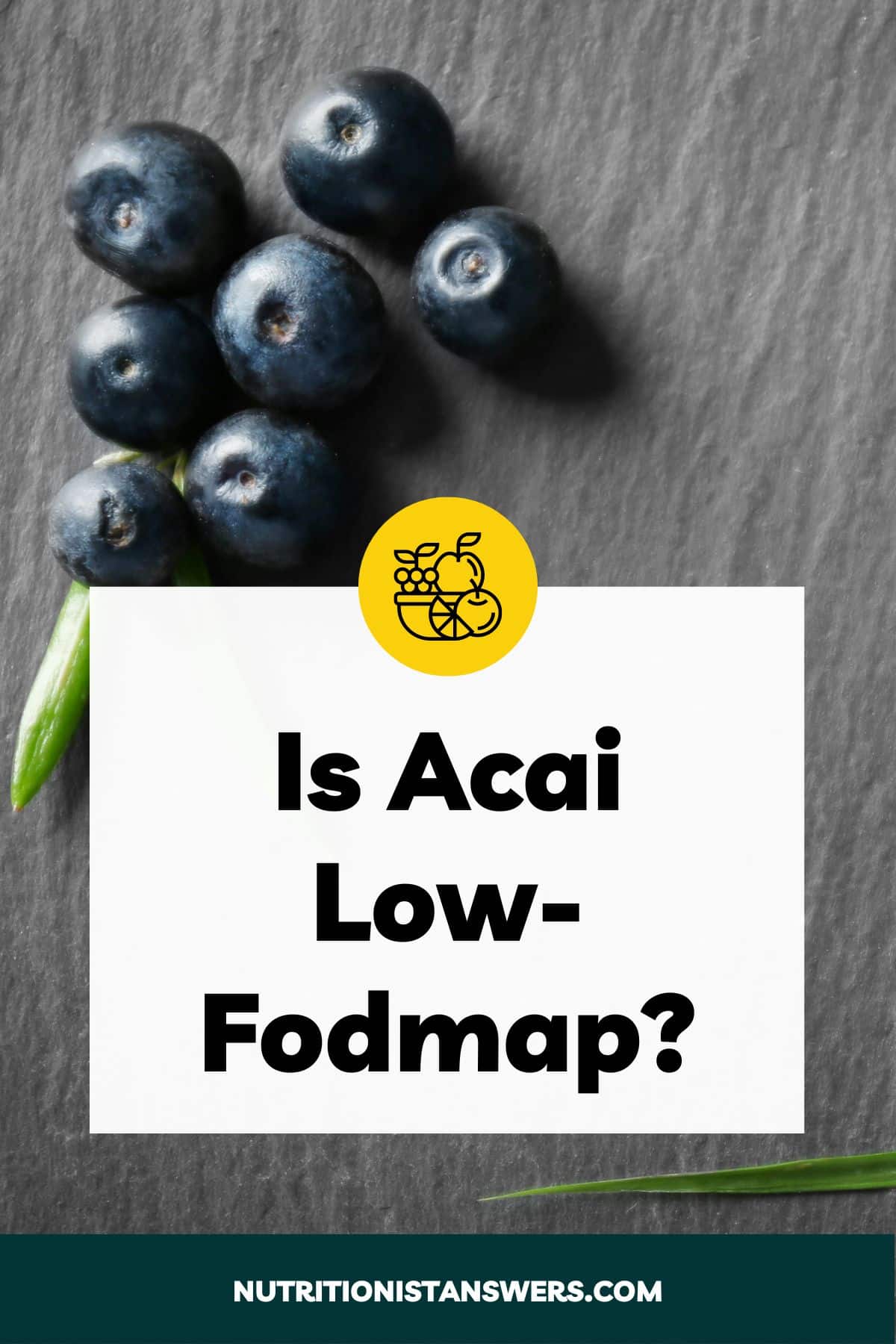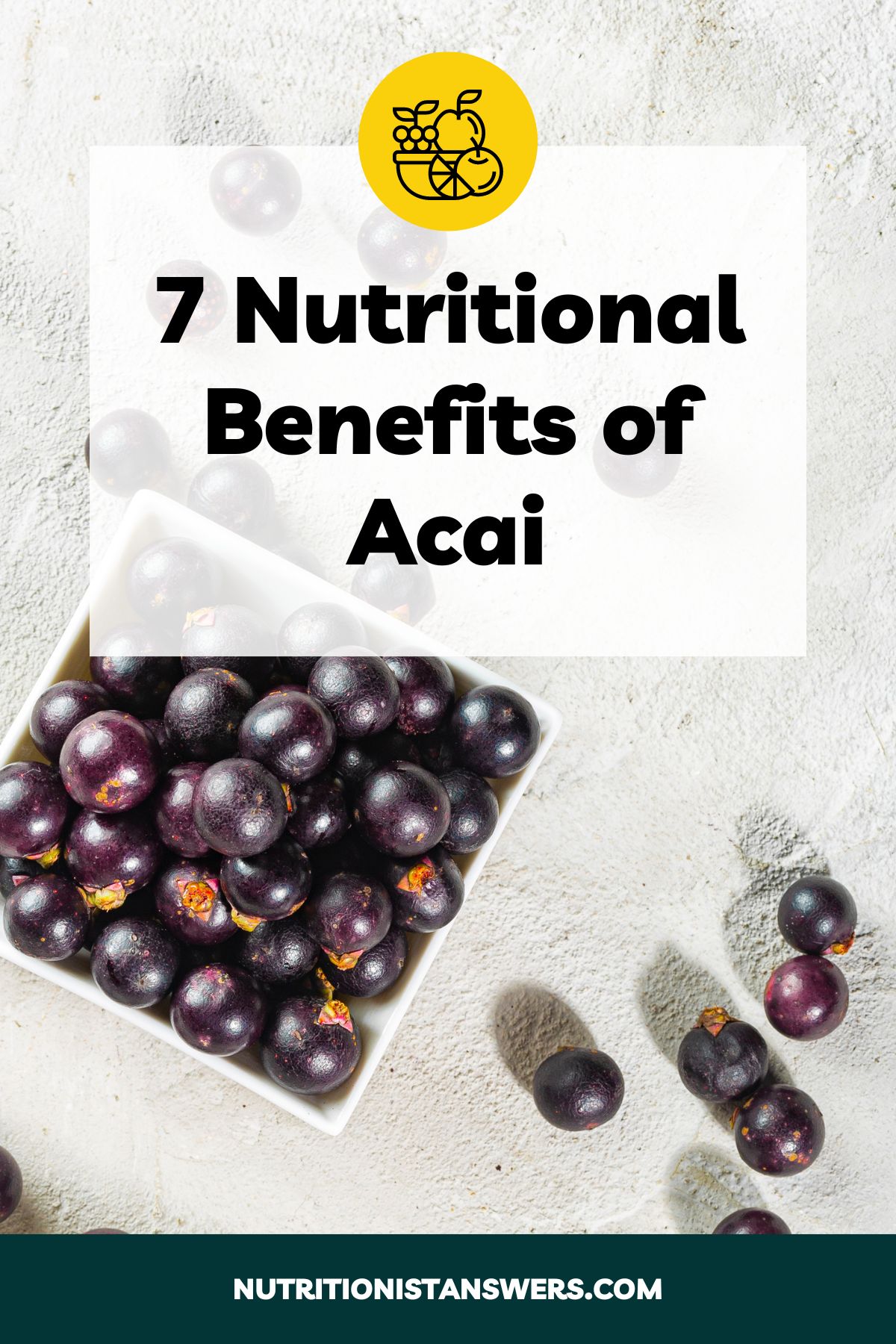Acai and pitaya are the queens of Instagram-worthy smoothie bowls.
These popular tropical fruits have similar uses, but you might be wondering how they compare when it comes to flavor and nutrition.
Keep reading to find out!
Please note that this article contains affiliate links. If you click one of these links and make a purchase, we may earn a commission. As an Amazon Associate, we earn from qualifying purchases.
What is pitaya?
Pitaya (also called dragon fruit or strawberry pear) is a medium-sized, oval-shaped tropical fruit native to Mexico, Central America, and Southeast Asia (1, 2).
The most common variety of pitaya has magenta-colored skin with pointy green scales (hence the name “dragon fruit”) and soft, white flesh speckled with tiny black edible seeds.
It has a very subtle flavor and just a hint of sweetness. Some people say it tastes like a milder version of kiwi, pear, or watermelon.
Other varieties of pitaya can have yellow skin and white flesh (called yellow pitaya), or magenta skin and deep reddish-pink flesh (called red pitaya), which has a sweeter, more vibrant flavor.
In the United States, frozen and powdered forms are typically the red-fleshed variety, while the white-fleshed variety is sometimes available in the produce section at supermarkets.
A popular way to eat pitaya is to slice it in half and scoop out the pulp with a spoon. It can also be peeled and diced into cubes for use in fruit salads and smoothie bowls.
What is acai?
Acai (“ah-sigh-ee”) berries are fruits produced by several species of Acai palm trees that grow in the Amazon rainforest (6).
They are small and round, with dark purple skin and a single large seed in the middle. Because of this, they are actually classified as drupes (or stone fruits) rather than berries.
Acai’s soft, juicy flesh tastes mostly bitter and earthy, but also slightly sweet and a bit tart. Many people have described its flavor as a cross between blackberries and dark chocolate.
For centuries, acai berries have served as a diet staple for indigenous people who live in the Amazon region of South America, including Brazil (6).
There are many ways to consume acai, but the most popular is açaí na tigela, which means “acai in the bowl” in Portuguese.
This popular dish is traditionally made by blending frozen acai pulp with guarana syrup, which is then poured into a bowl and topped with other fruits, nuts, and seeds.
When acai pulp was brought to the United States in the early 2000’s, the “acai bowl” became a trendy breakfast or snack option.
Pitaya vs acai
Pitaya cactus fruit and acai berries are both tropical fruits, but they have very different tastes and nutritional profiles.
Pitaya has a mild, sweet flavor, while acai is earthy and slightly bitter. Acai and pitaya have similar amounts of calories, but acai is much higher in fat, while pitaya is higher in carbohydrates. Acai is also much higher in vitamin A, vitamin C, calcium, and iron.
Here’s a more detailed review of how they compare in both flavor and nutrition:
Flavor comparison
Pitaya’s flavor is similar to kiwi, pear, or watermelon, while acai has been compared to blackberries and dark chocolate.
It might not be the sweetest fruit out there, but pitaya is noticeably sweeter than acai, which has a lower sugar content.
Unlike pitaya, acai is quite bitter, slightly tart, and has an earthy undertone that typically isn’t found in fruits.
If you want a fruit that’s mild and sweet, pitaya is the clear winner, but if you prefer something a bit more complex and bitter, then acai is the better choice.
However, you may not have to choose! These two fruits complement each other well, especially in smoothie bowls.
Nutrition comparison
Here’s a side-by-side comparison of the calorie and macronutrient content for pitaya and acai, based on a 3.5-ounce (100-gram) serving size (3, 7, 8, 9, 10):
| Nutrient | Red pitaya (fresh) (100g) | Acai (frozen pulp) (100g) |
| Calories | 60 | 65 |
| Protein | 1 gram | 2 grams |
| Fat | <1 gram | 5 grams |
| Carbohydrates | 13 grams | 5 grams |
| Fiber | 3 grams | 4 grams |
| Sugars | 8 grams | <0.5 grams |
Calories
Like most fruits, pitaya and acai are relatively low in calories. A 3.5-ounce (100-gram) serving of pitaya provides 60 calories, while an equal portion of acai offers 65 calories.
Protein
Acai contains slightly more protein — it contains 2 grams per serving, while pitaya has 1 gram.
However, both fruits are low in protein compared to foods like meat, fish, eggs, dairy, and legumes.
Fat
Acai’s fat content — 5 grams per serving — makes it unique among fruits, while pitaya contains almost no fat (<1 gram per serving).
For this reason, pitaya may be a better choice than acai for people who need to limit their fat intake, while acai may be a better choice for people following a lower-carb, higher-fat diet.
Carbohydrates
Acai provides 5 grams of carbohydrates per serving, making it a great option for anyone following a low-carb or ketogenic diet.
On the other hand, pitaya contains 13 grams of carbohydrates per serving and can serve as a quick energy source.
Vitamins and minerals
Unfortunately, there isn’t enough research on the vitamin and mineral content of pitaya and acai to be able to compare them fully.
Here’s what we can compare, based on a 3.5-ounce (100-gram) serving (3, 4, 7, 8, 9, 10):
| Nutrient | Red pitaya (100g) | Acai (100g) |
| Vitamin A | 50 IU (1% DV) | 1000 IU (20% DV) |
| Vitamin C | 2.4 mg (3% DV) | 10 mg (11% DV) |
| Calcium | 20 mg (2% DV) | 1.1 mg (6% DV) |
| Potassium | 120 mg (3% DV) | 105 mg (2% DV) |
| Iron | 0.7 mg (4% DV) | Iron: 1.1 mg (6% DV) |
As you can see, acai is significantly higher in vitamin A than pitaya. It also contains more vitamin C, calcium, and iron.
Red pitaya contains slightly more potassium than acai, but more studies are needed for a more comprehensive nutritional comparison.
Antioxidants
Both pitaya and acai are high in antioxidants.
Antioxidants help protect the body against unstable molecules (called free radicals) that can damage cells and contribute to many diseases (12).
Oxygen Radical Absorbance Capacity (ORAC) is one of the lab tests used to measure a food’s antioxidant power or ability to neutralize free radicals.
The ORAC scores for red pitaya and white pitaya are 7.6 and 3.0 µmol TEq per gram of fresh fruit, respectively (13). This means that red pitaya contains more powerful antioxidants than white pitaya.
Unfortunately, we couldn’t find an ORAC score for fresh acai berries (only powder), so it’s not possible to fairly compare the antioxidant capacity of these two fruits (14, 15).
We will update this article as new data becomes available.
Available forms
Pitaya and acai are available in several different forms, which we’ve listed below.
1. Fresh (pitaya only)
Although it can be difficult to find, more grocery stores are beginning to carry fresh pitaya in the produce section.
Unfortunately, fresh acai berries are highly perishable, so they aren’t typically available in the United States.
2. Frozen (pitaya & acai)
Both pitaya and acai can be found in the freezer section at many supermarkets and health food stores.
They are typically sold as smoothie packs (made from the pureed fruit), which can be purchased here and here. Frozen cubed pitaya is also sometimes available.
3. Powder (pitaya & acai)
Freeze-dried powder versions of acai and pitaya (the red-fleshed variety) are a great option for people who don’t have access to fresh or frozen fruit.
You can easily purchase pitaya powder here and acai powder here.
4. Juice (pitaya & acai)
Both pitaya and acai juice are available, although they often have to be ordered online. You can purchase them here and here.
However, these “juices” are typically made by mixing pureed fruit with water, sweeteners, and sometimes other types of fruit juices as well.
Final Thoughts
Pitaya and acai are both brightly colored tropical fruits that can be used in a variety of delicious recipes, including smoothie bowls and frozen desserts.
Acai is bitter and tart due to its low sugar content and contains more fat than most fruits, while pitaya is sweeter, higher in carbohydrates, and lower in fat.
If you live in the United States, you may be able to find fresh pitaya, while acai can only be found as frozen puree, juice, or powder.
So which one is better? Well, it’s up to your own personal taste and nutrition needs! Both can be fabulous additions to your diet.
Want to learn more about acai?
Check out our in-depth post:
Acai Berries: History, Nutrition, & Uses
Amy Richter is a Registered Dietitian Nutritionist based in Missouri. She is an experienced nutrition writer and medical advisor for Healthline and Medical News Today. Amy is passionate about all things food-related and enjoys translating complex science into easy-to-understand articles.





